
Phragmipedium is a genus of the Orchid family (Orchidaceae) and the only genus comprised in the tribe Phragmipedieae and subtribe Phragmipediinae. The name of the genus is derived from the Greek phragma, which means "division", and pedium, which means "slipper". It is abbreviated 'Phrag' in trade journals.
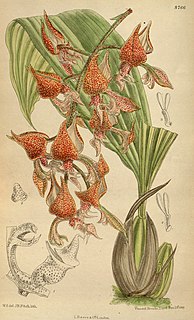
Gongora, abbreviated Gga in horticultural trade, is a member of the orchid family (Orchidaceae). It consists of 65 species known from Central America, Trinidad, and tropical South America, with most species found in Colombia. They grow in wide geographical range from wet forests at sea level to mountainous regions in the Andes, as high as 1,800 m.
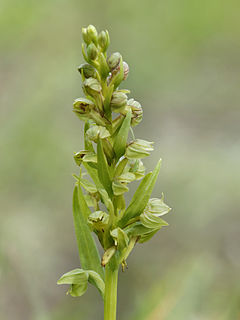
Coeloglossum is a genus of flowering plants in the orchid family Orchidaceae. It has long been considered to have only one species, Coeloglossum viride, the frog orchid. Some recent classifications regard Coeloglossum as part of the larger genus, Dactylorhiza, so that C. viride becomes Dactylorhiza viridis. Other sources continue to keep Coeloglossum viride separate.
Paphinia hirtzii is a species of orchid endemic to Ecuador.

Epidendrum armeniacum is an epiphytic species of reed-stemmed Epidendrum orchid that grows wild in Bolivia, Brazil, Ecuador, and Peru, at altitudes of 1–2 km.

Epidendrum blepharistes is a species of orchid in the genus Epidendrum native to Bolivia, Colombia, Costa Rica, Ecuador, Peru, and Venezuela.

Phragmipedium besseae is a species of orchid in the genus Phragmipedium. It is a terrestrial plant native to the wet montane forests on the eastern slope of the Andes in Colombia, Ecuador, and Peru.
Epidendrum parviflorum is a small-flowered reed-stemmed Epidendrum orchid found in the montane tropical wet forests of Bolivia, Ecuador, and Amazonas, Peru.

Epidendrum sophronitisLinden & Rchb.f. (1857) is a small Epidendrum orchid that bears a superficial resemblance to a Sophronitis, as the generic epithet was used prior to the year 2000.
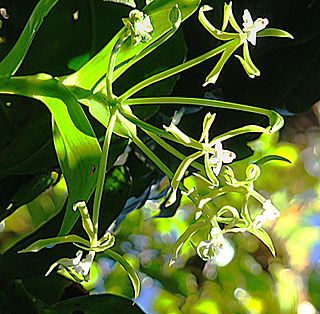
Epidendrum lacustre is a sympodial orchid which is known to grow both epiphytically and lithophytically in the cloud forests and rainforests of Colombia, Costa Rica, Ecuador, Nicaragua, Peru and Venezuela at altitudes ranging from 1.2—2.5 km. The type of this species was found growing "on half-submerged rotten trees" in a Venezuelan marsh at an altitude of 2.4 km.

Leporella fimbriata, commonly known as hare orchid or fringed hare orchid, is the only species in the flowering plant genus Leporella in the orchid family, Orchidaceae and is endemic to the southern Australia mainland. It is related to orchids in the genus Caladenia but has an unusual labellum and does not have hairy leaves. Its pollination mechanism is also unusual.

Lyperanthus, commonly known as beak orchids, is a genus of flowering plants from the orchid family, Orchidaceae, that is endemic to Australia. There are two species, one in Western Australia and the other in four eastern Australian states, distinguished by their single long, narrow, leathery leaf and dull coloured flowers which have prominent short calli on their labellum. Both form loose colonies which reproduce asexually from their tubers, and sexually using their flowers.
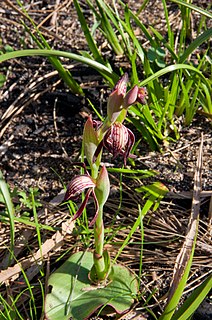
Pyrorchis, commonly known as beak orchids, is a genus of flowering plants in the orchid family, Orchidaceae and is endemic to Australia. It contains two species which were previously included in the genus Lyperanthus, also known as beak orchids. Both species have fleshy, oval leaves and form colonies which flower profusely after bushfires.

Cattleya iricolor is a species of orchid native to the eastern montane forests of Ecuador and Peru.

Leucospermum erubescens is an evergreen shrub of up to 2 m high, with hairless, lancet-shaped to oval leaves with three to seven teeth near the tip of 7–8½ cm long and 1–2 cm wide, slightly asymmetric, oval flower heads of 5–6½ cm in diameter, and usually with four to eight clustered near the end of the branches, with initially yellow flowers, that change to deep crimson, from which long styles stick out, giving the flowerhead as a whole the appearance of a pincushion. It is called orange flame pincushion in English and oranjevlamspeldekussing in Afrikaans. It can be found in South Africa. Flowers may be found between August and January.

Leucospermum glabrum is an evergreen, rounded, upright shrub of up to 2½ m (8 ft) high, that is assigned to the family Proteaceae. It has broad inverted egg-shaped leaves with seven to fourteen teeth near their tips, and oval flower heads of about 8 cm (3.2 in) in diameter, with hairy, orange and carmine-coloured flowers from which long styles with a thickened end emerge, giving the flowerhead as a whole the appearance of a pincushion. It flowers between August and October. Its common name is Outeniqua pincushion in English and Outeniekwa-kreupelhout in Afrikaans. It naturally occurs in a limited area on the south coast of South Africa.
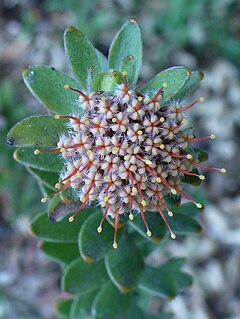
Leucospermum truncatulum is a slender, upright, evergreen, hardly branching shrub of up to 2 m (6 ft) high, with felty inverted egg-shaped to oval, leaves with entire margins of 1–2½ cm (0.4–1.0 in) long and ½–1 cm (0.2–0.4 in) wide. It has small globe-shaped, at first yellow, later pinkish flower heads of 1½–2 cm (0.6-0.8 in) in diameter, without a stalk, usually crowded with two to eight together near the end of the stems. It is known as oval-leaf pincushion in English, and patrysbos or kleinkopspeldekussing in Afrikaans. It is an endemic species of the south of the Western Cape province of South Africa, and flowers between August and December.

Leucospermum innovans is an upright evergreen shrub with many pustules growing on the lower branches, wedge-shaped leaves, and oval, flower heads that are yellow on the outside, but with scarlet stripes on the inside of the perianth claws, with long styles sticking far beyond the perianths, jointly giving the impression of a pincushion. It is called Pondoland pincushion or Transkei pincushion in English. Flowers occur on and off between July and December, but flowering peaks in September and October.
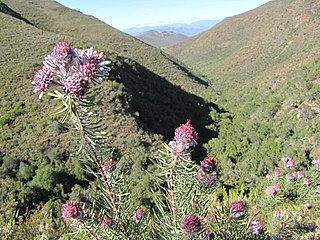
Vexatorella latebrosa, also known as the Robertson vexator, is an evergreen, upright shrub of up to about 1½ m high, from the family Proteaceae. It has entire, long inverted egg-shaped, bluish grey, leathery leaves that are line-shaped to very narrowly spade-shaped in outline, 5–6½ cm (2.0–2.6 in) long and 2–3 mm (0.08–0.12 in), and mostly solitary globular flower heads at the end of the branches of 2½–3 cm (0.8 in) across with scented, pink to carmine flowers with extended, styles with a thickened tip. The plants are flowering from August to September. It is an endemic species that is restricted to the Western Cape province of South Africa.
Rhizophora harrisonni is a species of plant in the family Rhizophoraceae. It can be found in Brazil, Cameroon, Colombia, Costa Rica, Ecuador, Guyana, French Guyana, Honduras, Nicaragua, Panama, Suriname, Trinidad, Tobago, and Venezuela.

















